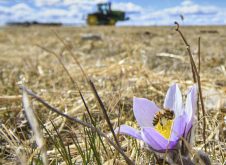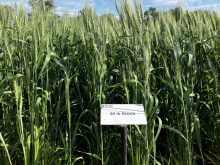Manitoba grows nearly 90 per cent of Canada’s sunflowers. The remaining acreage is in Alberta. On the world scale, though, this is a very small percentage of the global sunflower crop.
Sunflowers, just like corn, were “domesticated” thousands of years ago in North America, primarily in Mexico. The sunflower is a member of the daisy (Compositae) family. There are many different kinds of sunflowers — annual, perennial, multi-stemmed. Over the thousands of years of cultivation by indigenous peoples of the Americas, they developed a large-headed single-stemmed type of sunflower that had much bigger seeds. The indigenous peoples did the same thing with corn: they took a multi-stemmed, wheat-like grassy plant and concocted it into a big single-stemmed plant usually with a single big-seeded cob.
Sunflowers, by the time of Columbus, were grown as a food crop in both North and South America. The crop was grown in the U.S., primarily in Arizona and New Mexico. In the 16th century, sunflowers found their way to Europe, first via Spain before moving into central countries such as Ukraine and Russia. In the 19th and 20th centuries, up to recent times, the Russians in particular developed spectacular vigorous high-oil-yielding types. These sunflowers were from crosses with wild varieties which now form the basis of all agricultural sunflowers grown in North America. It was the Russian and Ukrainian researchers who brought disease resistance into the plants, also bringing in these vigorous large-seeded hybrid lines.
Read Also

Claas brings 1000 Series SP forage harvesters to Canada
In mid-August, Claas unveiled its new line of Jaguar forage harvesters at an event in Visalia, California, deep in the heart of that state’s dairy region.

When we look at world production of sunflowers, primarily for oil, the European producers grow huge acreages. This results in sunflower oil becoming the No. 1 oil consumed in Europe. The following, in millions of metric tonnes, are the tonnages of sunflower seed from the world’s biggest producers in 2023:
- Russia: 17.1 million
- Ukraine: 14.5 million
- European Union: 10.2 million
- Argentina: 4.1 million
- Turkey: 1.5 million
The U.S. production is mainly in North and South Dakota — around 500,000 and 400,000 tonnes, respectively — accounting for about 90 per cent of the U.S. acreage. Canada’s sunflower crop reached its greatest yield, of over 200,000 tonnes, in the 1970s, but in more recent years the crop has run either side of 90,000 tonnes (50,680 in 2024). This tonnage in Canada is divided into the oil black-seeded types, with differing oil content profiles, and confection-type sunflowers with stripped hulls, directly used for human consumption.
On the world scale, sunflower oil ranks fourth, just behind canola oil production. Palm oil is No. 1 and soybean oil is No. 2. Crop-wise, sunflower oil is grown on around 75 million acres worldwide (30 million ha).
Sun burns
Some 30 years ago I attended a seminar at Saskatoon given by a retired entomologist. He had spent his entire career working on and evaluating insect pests of sunflowers. During his entomological research he evaluated some 25 insect pests of the sunflower crop that occurred in Canada. His conclusion was that while some of these pests could be locally damaging to a sunflower crop, none of the insects were to be considered major problems. Of course, there were outbreaks of insect damage on the sunflower crop, but on a year-by-year basis none really warranted economic insecticide control. His insect descriptions, life cycles and photography were first-class. His work became the basis for identifying sunflower insect pests used to this day in North America.
Diseases of sunflowers, on the other hand, can be major problems. Downy mildew, rust and sclerotinia white mould are the major disease pests of this crop. Researchers have had success with breeding for resistance to rust and downy mildew, but sclerotinia remains a major problem.
In my travels in Manitoba and the Dakotas I worked with several sunflower growers on a number of problems. The primary problem, though, was sclerotinia. Unlike canola, where sclerotinia only affects the above-ground parts via ascospores, root infection by the black sclerotinia sclerotes in the soil is a major problem. The black sclerotes can survive in the soil for 10 years or more.

Look up my Alberta Agriculture fact sheet, “Disease Forecasting for Sclerotinia White Stem Rot in Canola” (Agdex 149/632-4). Some of the information may be outdated but the sclerotinia life cycle is excellent.
As well as root infection, sunflowers can be heavily damaged by airborne sclerotinia ascospores on open flowers as well as on stem shoots. The sclerotinia sclerotes pictured in the aforementioned fact sheet can germinate to produce fungus mycelium. Canola roots are immune to this mycelium, but sunflower roots are very susceptible to infection. As a consequence, the entire sunflower plant can wilt and die in a matter of days. That’s why sunflower can suffer major disease losses on canola-grown croplands, even under dry growing seasons. These hard black sclerotes left over from a canola crop can persist in the soil for many years. In the soil the sclerotes under dry condition are not a threat to canola plants, but they can infect the roots of sunflowers and cause significant crop loss.
My information on sunflower wilt caused by sclerotinia is best described by my personal experience. I live on five acres of land near Devon, Alta. I have a driveway that’s over 100 feet (30 metres) long. I grew ornamental sunflowers on both sides of the driveway. They ranged from dwarf white types to maroons, yellows and even double-bloom types. I have been a sunflower grower for over 25 years.
On the east side of the driveway, in the first few years, I had an outbreak of sclerotinia that killed off some 20 plants. There was no sclerotinia damage on the west side of the driveway. I usually left the damaged plants overwinter, removing them in May of the following year. In removing the overwintered diseased stems, roots and flower heads I must have inadvertently infested the east side of the driveway with the black sclerotes. I kept growing sunflowers on both sides of the driveway annually. On the east side of the driveway, I would remove any sunflower plant that showed any sign of wilting from sclerotinia root infection. In the first few years I would remove about 25-50 per cent of the sunflower plants. No sunflower root infection ever occurred on the west side of the driveway. It was 12 years in a row before I removed the last sclerotinia-infected plant from the east side of the driveway and had them burnt, ASAP. That’s just to prove to you that sclerotes can persist in soil for at least 10 years or more once your soil has been infested with this destructive fungus.
If you want to get into sunflower growing, Manitoba Agriculture has a first-class sunflower-growing guide on the net, “Sunflower Production and Management.”
















